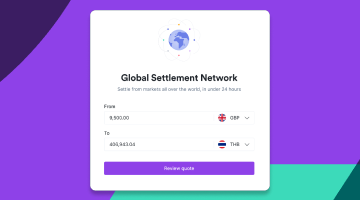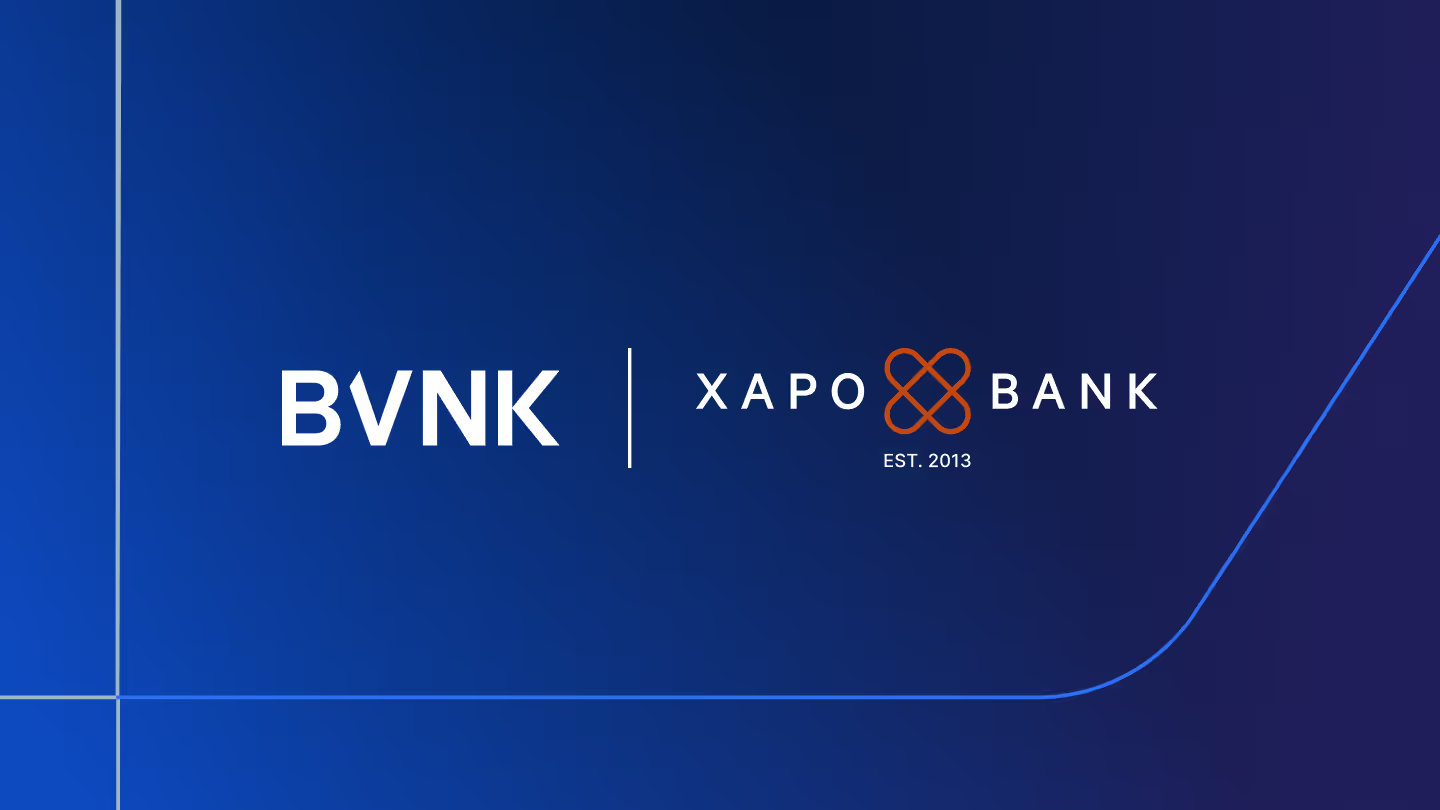Paying international vendors and suppliers: 2023 guide for businesses
A comprehensive guide for global businesses

Introduction
Analysts estimate that businesses will spend $39.3 trillion making international payments to vendors and suppliers in 2023, and $56.1 trillion by 2030. Add the wholesale banking sector to that (which includes institutional investments and currency trading), and the current value of B2B cross-border payments is $186.2 trillion, accounting for 98% of all international transactions. But within existing systems for paying international vendors and suppliers, there can be lots of inefficiencies. Some payment methods are costly, impacting both the payer and payee; while some payment methods are relatively slow, which affects the recipient’s cash flow.
In this guide we will explore the various ways that businesses can pay their international vendors and suppliers, and highlight the key advantages and shortcomings of each. Finally, we will explain the benefits of working with an international payments partner, and how to select the best cross-border payments provider for your business.
Entering the global market: why paying international vendors matters
There are a variety of reasons to explain the significant increase in businesses making international vendor payments. These include the emergence of B2B ecommerce, the rise of developing markets, favourable geopolitical and trade relations, and innovations in transport and technology. Better payments are another driver of global business growth.
In the last decade especially, international payments have undergone seismic improvements. Today, it is easier and cheaper than ever for a business to pay its international vendors and suppliers. Companies that have adopted these improvements are at a distinct advantage.
Conversely, those that continue to rely on outdated, inefficient cross-border payment methods are impacted by excessive transaction costs, complex and manual workflows, slow settlement times, and high payment failure rates. These factors directly hit their profitability, and make them less attractive to vendors and suppliers that prioritise customers that pay promptly. This makes the challenge of paying international vendors effectively a cornerstone of competitive advantage.
First-hand experience: accelerating payments to global suppliers
Greenburg Pro is a global IT consultancy, providing day-to-day IT support to software integrations and app development. It employs hundreds of IT contractors around the world, mainly in Bangladesh and India. Paying them had been slow, taking funds up to a week to arrive. That meant Greenburg either sent the payment in advance (impacting cash flow), or the contractor would have to wait to receive their money, affecting supplier relations and ultimately the company’s ability to serve its clients.
Today, Greenburg Pro uses BVNK’s Global Settlement Network to convert millions of euros each month into USDT stablecoins, and pay out to contractors around the world in just a few hours. Read the full story.

Pay global suppliers with ease
How to pay your international vendors and suppliers
Businesses have lots to think about when defining their cross-border payments strategy. In this section we look at the key risks to consider when deciding the most effective way to pay your international vendors and suppliers; and how to mitigate them.
The larger and more diverse your business is, the more you will need to tailor your strategy for different vendors and suppliers. Segmentation can be performed by sector, geography, transaction volume and value, as typical examples.
Risks and costs: factors to consider before paying international vendors
There are a variety of risks and costs associated with making international payments to a vendor. These include:
Vendor’s payment terms
A vendor’s payment terms can include the timeframe for payment, fees for late payments, and costs associated with processing international payments. Your business should have clarity on these terms, and where possible negotiate them.
Foreign exchange rates
If the vendor stipulates that payment has to be received in its domestic currency, it will be subject to a foreign exchange conversion. This adds costs, and also carries the risk of currency slippage.
Legal compliance
Businesses are subject to domestic trading rules. Governments can impose restrictions (or complete bans) on trading partners, specific payment methods, and the outflow of foreign currency. Vendors are also subject to these rules in their own jurisdiction, which can impact a company’s ability to pay them.
Political instability
From a change of government to the outbreak of civil unrest or a widespread systems failure, countries can be subject to sudden events that significantly alter or destabilise its financial apparatus.
Minimising the risks and costs of paying international vendors
Each of the factors described in the previous section can make it harder to pay a vendor in a different country, or add costs to doing so. These risks and costs can be minimised by taking a proactive approach. Actions that a business can take include:
Agree on the payment currency
Agreeing on the payment currency with a foreign vendor avoids the risk of exchange rate fluctuations and simplifies reconciliation and accounting. Paying and settling in the same currency will also tend to be faster and less costly than transacting in two (or more) currencies, and will eliminate certain compliance obligations.
Time your payment
Keeping a close eye on the currency markets, including using predictive analysis tools, can ensure a vendor payment is timed to benefit from optimal exchange rates. Hedging strategies and forward contracts are other tactics that companies use to minimise the risk of unfavourable currency price moves.
Negotiate payment terms
A vendor’s payment terms are only applicable once you’ve agreed to them. So look to negotiate on the risks and costs you have identified. Look beyond the basic price to factors that can have as much, if not more, impact, such as the payment deadline, bank network fees, acceptable payment methods and currencies. Also, see if the vendor will provide incentives for agreeing to its terms, such as discounts on future orders. Read more about how to negotiate payment terms with international suppliers in this helpful article.
Enable alternative payment methods
Some vendors will mandate a payment using a specific method that your business does not currently use. This can add time and expense to setup and integrate with your other payment systems. This can be mitigated by adopting a global payments platform that provides access to your preferred payment methods. With more cross-border business payments set to be made using stablecoins, businesses should look for a payment platform that offers this method.
Choose the best way to pay overseas suppliers
There are a range of methods that a business can use to pay an overseas supplier. In this section we will look at the leading options. When choosing the best international payment methods, businesses should consider their specific needs and circumstances. This includes the performance of your existing payment systems, integrability with wider financial software, growth projections (both volume and geography), and synergies with vendor’s systems and preferences.
Card networks
International card networks (eg Visa, Mastercard, Amex) are popular ways for businesses to pay foreign suppliers. Card payments using these networks can be a good option for cross-border transactions as they are widely accepted, convenient and secure. They are becoming more important in the B2B sector as more commerce moves online. They can also reward businesses that buy more through incentive schemes. However, card transactions may be subject to currency conversion fees and other charges, as well as caps on payment amounts; and because they leverage banking networks to move money, they share the same issues.
Swift
Swift (Society for Worldwide Interbank Financial Telecommunication) is the dominant method for processing cross-border payments. Swift is used by more than 11,000 member institutions. They include all sorts of financial organisations that need to move money internationally — banks, brokerages and trading houses, securities dealers, asset management companies, clearing houses, depositories, remittance services, and non-financial businesses. Collectively they send an average of 44.8 million payment messages daily through the network. The benefits of Swift include its global scale and trusted technology, while it has also rolled-out new innovations in recent years, such as Swift gpi. But Swift also has flaws, including opaque fee structures, slow settlement times, technical complexity and political influences.
Other banking networks
Global ACH (also called International ACH Transfer) is a method for moving money between US and foreign bank accounts, using other country payment rails including EFT, SEPA, BACS and BECS. SEPA (Single Euro Payment Area) is a dominant international banking network in Europe. Domestic banking networks can also be used in combination to process international payments, such as Fedwire (US), CIPS (China), BACS (UK), BECS (Australia) and EFT (Canada). India and Singapore have recently linked their digital payments systems, UPI and PayNow, to enable instant and low-cost fund transfers, with customers from eight banks able to benefit.=
Escrow
Providers of Escrow payments act as intermediaries, holding funds until certain conditions are met in the transaction. Escrow payments are popular for international transactions where there tends to be less familiarity between buyer and seller. A ‘Letter of Credit’ and ‘Documentary Collection’ methods work on a similar basis, with the business customer and vendor’s banks acting as trusted (and in some cases, liable) administrators.
Prepaid cards
Some businesses issue prepaid cards to employees or partners to pay vendors. These cards can be preloaded with funds and used for specific purposes.
Fintech networks
Fintechs layer services on top of banking networks to solve some of the traditional challenges of moving money internationally. Examples of these services include pre-funding to simulate 'instant' payments, automatic rerouting of payments to identify the fastest and most effective settlement path, and real-time information about the progress of the payment. Fintechs can also support with the integration of complimentary systems such as FX, management of compliance obligations, and enhanced customer support. A fintech provider allows businesses to offload much of the work involved in making cross-border payments, allowing them to redeploy resources to core activities. Some of the leading fintech providers of cross-border payments are PayPal, Stripe and Wise.
Blockchain and cryptocurrencies
Juniper Research estimates that B2B cross-border payments on blockchains will account for 11% of the total B2B international payments by 2024. Driving adoption is the relative speed, security, transparency and lower processing costs of blockchain-enabled payments. One study found that blockchain-enabled cross-border payments could save businesses $10 billion by 2030.
Stablecoins are likely to be the currency of choice as they overcome the volatility issue of other cryptocurrencies. Stablecoins, whose value is pegged to an underlying asset (often a fiat currency) have a collective market cap of approximately $129 trillion (at time of publication). Over $30 billion in trades are made every day using stablecoins, with settlements reaching approximately $8 trillion in 2022, surpassing volumes of major card networks like MasterCard and American Express.
Businesses can pay vendors directly using stablecoins, or as an intermediary currency to settle into fiat currency. The fiat currency is instantly converted to stablecoins, which is moved across the blockchain and then converted into the settling currency, nullifying the risk of currency conversion.
BVNK’s cross-border payment solution — Global Settlement Network — uses stablecoins to help merchants move funds from emerging markets and settle between currencies quickly and reliably. And Stripe, one of the world’s largest fintechs, now offers merchants the ability to make payouts in crypto through the stablecoin USDC, which is issued by crypto firm Circle.
Visa is now allowing its partners to send or receive USDC settlement payments via the Solana blockchain, and says 15,000 financial institutions are currently using the service. Meanwhile American Express has been working with Ripple since 2017 to process blockchain-enabled international B2B payments.
Select the right international payment provider
Businesses looking at new ways to pay their international vendors and suppliers should work with an experienced payments partner. An effective payments partner should be able to help your business through find the most effective cross-border payment option. Ultimately, their value is in supporting your business to make vendor payments faster, more cost-effective, and more secure.
There’s lots to consider when choosing to appoint an international payments partner, and every business will have a different set of priorities. In this section we give you some key criteria that you can use to appraise potential cross-border payment partners.
Fees
It’s important to know how each international payment provider charges for processing cross-border transactions, as these differ. Fees are typically charged as a percentage of the transaction amount or as a flat fee per transaction, or a combination of both. These fees can vary depending on the payment method, the destination of the payment, the volume of payments and their values. Large businesses with a high volume of payments may be able to negotiate a customised price. Businesses may also incur one-time setup or integration fees when they first start using a payment partner's services; and regular management and maintenance fees in the form of a subscription. Look out for services that aren’t included in the basic price, such as fraud protection, tokenisation, recurring billing, and analytics. And also fees for chargebacks and failed payments.
Coverage
Select a payment provider that has a global reach but can also accommodate local market customisations. As a start they should have all the necessary licences, memberships or regulatory coverage to acquire and process payments in each of your markets.
Breadth of capabilities
A mature cross-border payments operation is not simply about moving money from A to B. It’s also managing fraud, optimising settlement times and costs, access to data and insights, and complying with regulations. It can be more efficient to get all these capabilities within one platform, though not at the risk of access to best-in-class tools and operational resilience.
Ease of deployment
APIs and plug-and-play services make it easy to get started with a partner, integrate third-party solutions, and scale.
Processing times
Have a clear understanding of the settlement times that a provider commits to in its Service Level Agreements (SLAs). This will determine when you need to release money from your business to pay vendors, which (as well as costs) has the most profound impact on cash flow.
Technical support
Cross-border payments are a highly technical exercise, and you should have immediate access to support to fix things when they go wrong. Look for support teams in each of your major markets, so you get round-the-clock support.
Compliance
Though typically a payment partner will take on the burden of regulatory compliance, your business could still be liable. Look who’s in their compliance team, if they have detailed governance and oversight framework that clearly articulates policies and procedures; and how compliance is embedded throughout the solution.
Check out BVNK’s 10 cross-border payments companies to know about.
Building strong relationships with international suppliers
There’s more to building and maintaining strong relationships with international suppliers than just payments. In this section we will look at some of the other factors that contribute to a professional and profitability partnership with your overseas vendors.
Communicate clearly
How often you communicate, on what issues, and even in what language can have profound implications for the way your vendors perceive you. Clarity is essential; when suppliers understand your specific requirements and standards, they can tailor their processes to meet them consistently. This leads to fewer quality control issues and customer complaints. Tone is also important. When suppliers feel valued and respected, they are more likely to share information, anticipate potential issues, and work collaboratively to solve problems. Appointing a dedicated person to manage the relationship with a vendor can provide consistency and familiarity to communications.
Show commitment
Suppliers who trust your commitment to a long-term partnership are often more willing to be flexible and adapt to your changing needs or market conditions. This adaptability can help your business navigate challenges and seize opportunities effectively. Commitment can be established in contractual terms, such as length of tenure or minimum sales volumes. Taking a proactive interest in your supplier’s business - such as asking to collaborate on their roadmap, having a seat on their board, or simply travelling to their offices - are other ways to express commitment.
Negotiate fairly
Negotiate terms that are fair to both parties. Think about every aspect of the relationship - product quantity and quality, delivery timeframes, payment schedules - and record agreements in a SLA. Also be specific and transparent about the implications of any term not being met, by either side. This clarity can prevent misunderstandings and disputes later.
Resolve disputes amicably
When disputes arise, approach them with a problem-solving mindset. Seek to understand the supplier's perspective, and work together to find mutually beneficial solutions. Though you ultimately want to protect your own business’ interest, think about the cost implications and potential interruption of having to appoint a new supplier. If the dispute cannot be resolved amicably, ensure you instruct lawyers clearly and with all the information they need to legally close the contract.
Paying international suppliers made easy
In a globalised world, businesses are more inclined to look abroad to find appropriate suppliers and vendors. When it comes to payments, businesses have more choice than ever about how to pay, and get paid. But more choice can be overwhelming; and with costs, cash flow and supply chain relations all potentially impacted, navigating the world of B2B international payments can be complex.
Appointing a trusted international payments partner is the best way to offload this complexity, and identify and enable the right payment methods for your business. That leaves your business free to concentrate on the other aspects of supply chain management.
BVNK is a next generation payments platform connecting today’s financial systems with distributed ledger technology to create modern rails for moving money. We process billions of dollars in payments every year for hundreds of businesses globally. With our Global Settlement Network you can send or receive any currency in less than 24 hours, expand to new markets more easily, free stuck funds and pay global suppliers on time.

How Greenburg Pro paid global contractors on time
Latest news
View allGet payment insights straight to your inbox



.jpg)







.avif)


.jpg)





